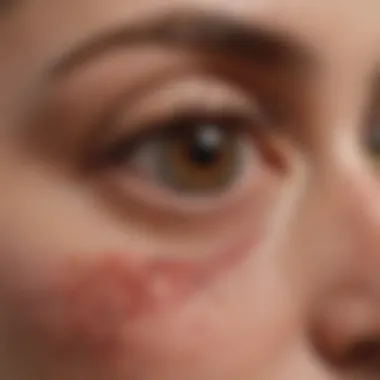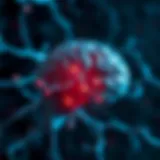Insights into Cutaneous Squamous Cell Carcinoma


Intro
Cutaneous squamous cell carcinoma in situ (cSCCis) represents an early form of skin cancer that, while localized and potentially treatable, poses significant concern in dermatological practice. As healthcare professionals and researchers delve into its complexities, understanding the intricate details surrounding this condition becomes vital. The relevance of cSCCis lies not just in its prevalence but also in the implications for patient health, dermatologic treatments, and advancements in medical research.
Recognizing the pathophysiology of cSCCis can help in creating effective management plans. The contemporary discussions surrounding its diagnosis and treatment strategies showcase the evolving landscape of dermatologic oncology. As knowledge increases regarding risk factors and prognostic markers, it becomes essential for professionals to stay informed.
This article aims to provide insights that are deeply rooted in the latest research. In doing so, we highlight the urgency of early detection and intervention. Readers will find valuable insights that can enhance their understanding of how to recognize, diagnose, and manage this prevalent skin condition.
A key focus will be on emerging strategies that aim to improve patient outcomes. Ultimately, the synthesis of this information will serve both students and professionals in delivering informed care and leading future conversations in the field of dermatology.
Prelims to Cutaneous Squamous Cell Carcinoma
Cutaneous squamous cell carcinoma (CSCC) is a critical topic within dermatologic oncology. Understanding this condition is essential due to its growing prevalence and potential complications. This section introduces the nature of CSCC, setting the stage for a more in-depth discussion in subsequent sections.
Definition and Distinction
Cutaneous squamous cell carcinoma in situ is defined as a localized neoplasm that originates from keratinocytes. It is characterized by abnormal growth in the epidermis, the outermost layer of the skin. Unlike invasive squamous cell carcinoma, where cancer cells penetrate deeper into the skin, in situ carcinoma remains confined to the epidermis. This distinction is vital because it influences treatment decisions and prognostic outcomes.
Key features of cutaneous squamous cell carcinoma in situ include:
- Non-invasive: It does not spread to other tissues.
- Potential for progression: If left untreated, it may develop into invasive carcinoma.
- Varied presentation: It can appear as scaly patches, ulcers, or lesions, which may be mistaken for other skin disorders.
Epidemiology
The epidemiology of cutaneous squamous cell carcinoma in situ reveals significant insights into its impact on public health. This condition accounts for a substantial portion of skin cancer diagnoses worldwide.
- Incidence: The incidence of CSCC has been rising due to various factors including increased sun exposure and outdoor activities.
- Demographics: Most cases occur in fair-skinned populations, especially among individuals over the age of 50. However, a growing number of cases are seen in younger people, potentially linked to tanning bed usage.
- Geographical variations: Skin cancer rates are higher in regions with intense sun exposure, such as Australia and parts of the United States.
"Understanding the epidemiology of cutaneous squamous cell carcinoma in situ is crucial for developing effective prevention strategies and health policies."
Research continues to explore the demographics and behaviors associated with increased risks, informing public health initiatives aimed at reducing incidence rates.
Pathophysiology of Cutaneous Squamous Cell Carcinoma in Situ
Understanding the pathophysiology of cutaneous squamous cell carcinoma in situ (cSCC in situ) is crucial for grasping its nature and management. This section delves into the cellular mechanisms involved and the genetic alterations that contribute to this condition. Recognizing the underlying processes aids not only in effective diagnosis but also in tailoring treatment strategies. Key in this discussion are the pathways of cellular differentiation, the immune response, and the role of genetic instability in the skin's epithelial cells.
Cellular Mechanisms
The cellular mechanisms of cSCC in situ primarily revolve around keratinocyte behavior. Under normal circumstances, keratinocytes undergo a well-regulated lifecycle of proliferation, differentiation, and apoptosis. However, in cSCC in situ, this orderly process is disrupted. The keratinocytes accumulate in an uncontrolled fashion, leading to the thickening of the epidermis known as acanthosis.
In addition, there are significant alterations in the signaling pathways that govern cell growth. The dysregulation of the p53 tumor suppressor gene plays a pivotal role. Normally, p53 functions to initiate DNA repair, facilitate apoptosis, or halt the cell cycle in response to DNA damage. When mutated, however, it fails to perform these protective functions, allowing damaged cells to proliferate.
Furthermore, the immune system's role is also noteworthy. cSCC in situ can evade an immune response due to local immunosuppression. This dissociation contributes to tumor growth and persistence, as the body's defenses are compromised.
Genetic Mutations
Genetic mutations are fundamental in the development of cSCC in situ. The most prominent mutation involves the TP53 gene, which is frequently mutated in skin cancers. Exposure to ultraviolet (UV) radiation is a primary risk factor, leading to DNA damage that is often misrepaired, hence resulting in p53 mutations.
Additional mutations may involve the HRAS oncogene. Mutations in HRAS can activate pathways that promote uncontrolled cell growth, further propelling the transformation of keratinocytes into malignant forms.
In aspects of genetic predisposition, variants in the genes related to DNA repair mechanisms can enhance susceptibility to cSCC in situ. Individuals with an inherited predisposition or predisposed conditions, such as xeroderma pigmentosum, showcase the critical need for understanding these genetic factors. It is through such insights that targeted therapies can be developed, aiding in prevention and effective management of this skin condition.
"Understanding genetic mutations illuminates the path to innovative treatment approaches for cutaneous squamous cell carcinoma in situ."
Recognizing the pathophysiological aspects of cutaneous squamous cell carcinoma in situ is essential for effective intervention. This knowledge not only informs clinical practices but also supports ongoing research efforts aimed at improving outcomes for affected individuals.
Risk Factors Associated with Cutaneous Squamous Cell Carcinoma in Situ
Understanding the risk factors associated with cutaneous squamous cell carcinoma in situ is crucial in the effective management of this condition. Identifying these factors can lead to earlier detection, improved prognostic evaluation, and better patient education strategies. As this article explores, both environmental and genetic elements play a significant role in increasing susceptibility to this skin cancer. By assessing risk factors, healthcare professionals can implement targeted preventive measures, optimize screening protocols, and engage patients in informed discussions about their health risks.


Environmental Exposures
Environmental factors contribute significantly to the risk of developing cutaneous squamous cell carcinoma in situ. Key exposures include prolonged and unprotected exposure to ultraviolet (UV) radiation, either from sunlight or artificial sources like tanning beds. The relationship between UV exposure and skin cancer is well documented. People with occupations that require significant time outdoors, such as construction workers and farmers, may have a higher risk. Additionally, living in areas with high sunlight intensity can increase susceptibility.
Other environmental carcinogens also play a role. For example, chemical exposure from substances like arsenic, coal tar, and certain oils can elevate the risk of skin cancer. Individuals who frequently use these products should be aware of their potential hazards.
Certain skin types, particularly fair skin that burns easily, also heighten risk. An awareness of one’s skin phototype can assist in lifestyle changes, such as using sunblock or wearing protective clothing when outdoors.
Genetic Predisposition
Genetic factors are another crucial element in understanding the risk of cutaneous squamous cell carcinoma in situ. Specific genetic mutations can increase susceptibility to this cancer type. For instance, individuals with a family history of skin cancers may carry genetic predispositions that elevate their risk.
Moreover, conditions such as xeroderma pigmentosum, a rare genetic disorder affecting the skin's ability to repair UV damage, illustrate the link between genetics and skin cancer susceptibility. People with this condition face significantly higher risks of developing skin tumors at a young age.
The role of genetic testing in cancer risk assessment is growing. While it may not be routinely performed for cutaneous squamous cell carcinoma, understanding the genetic background allows for more personalized patient care and preventive strategies.
Overall, recognizing the interplay of environmental and genetic factors is vital in the approach to cutaneous squamous cell carcinoma in situ. Such knowledge empowers both patients and healthcare providers to advocate for preventive measures and early detection, ultimately improving outcomes.
Clinical Presentation
The clinical presentation of cutaneous squamous cell carcinoma in situ (cSCCis) is critical for early detection and effective intervention. Understanding its signs and symptoms allows clinicians to differentiate it from benign lesions and other malignancies. The importance of recognizing these characteristics cannot be overstated, as timely diagnosis significantly impacts treatment outcomes. In this article, we will discuss the specific components of the clinical presentation that aid in identifying cSCCis and why they matter in clinical practice.
Signs and Symptoms
Cutaneous squamous cell carcinoma in situ may present with varied signs and symptoms, often depending on the location and extent of the lesion. Here are some common indicators:
- Erythema: A patch of red, inflamed skin is commonly observed.
- Scaling or Flaking: The affected area can display dry, scaly patches that may resemble eczema or psoriasis.
- Ulceration: In some cases, the lesions can develop open sores that do not heal properly, which is a critical sign for clinicians to recognize.
- Change in Skin Texture: The lesion may feel thickened or rough to the touch, distinguishing it from surrounding healthy tissue.
- Bleeding or Crusting: Any bleeding or crust formation can indicate an advanced stage and should prompt immediate evaluation.
These symptoms might be mistaken for other skin conditions, highlighting the need for a thorough assessment. Patients may experience no symptoms at all, especially in early stages, making regular skin checks essential for high-risk individuals.
Differential Diagnosis
Differential diagnosis is vital to accurately identify cSCCis and avoid misdiagnosis. Several conditions can mimic its presentation, including:
- Actinic Keratosis: Often regarded as precancerous lesions, these appear similar but may not possess the invasive characteristics of SCC.
- Basal Cell Carcinoma: Like cSCCis, this is a common skin cancer; however, it typically shows different clinical features, such as a pearly appearance.
- Psoriasis or Eczema: Chronic inflammatory conditions that cause similar scaling and redness, posing a challenge in diagnosis.
- Seborrheic Keratosis: A benign skin growth that can be confused with malignant lesions due to its rough texture.
Understanding these distinctions is essential for effective management, as treatment strategies vary considerably between these conditions. Misdiagnosis can lead to delayed appropriate therapies, worsening the patient’s prognosis.
Clinicians must perform thorough examinations and possibly biopsy any suspicious areas to ensure accurate diagnosis. This vigilance is paramount to avoid complications and achieve favorable outcomes in managing cutaneous squamous cell carcinoma in situ.
Diagnosis of Cutaneous Squamous Cell Carcinoma in Situ
Diagnosis plays a crucial role in the management of cutaneous squamous cell carcinoma in situ (cSCC in situ). Early detection is vital, as it significantly influences treatment outcomes, reducing complications and recurrence rates. The diagnostic process includes a variety of methods aimed at confirming the presence of the condition while differentiating it from other skin disorders. A thorough understanding of diagnostic techniques allows healthcare practitioners to implement timely interventions that can enhance patient prognosis.
Clinical Examination
The clinical examination is the first step in diagnosing cSCC in situ. During this initial assessment, healthcare providers visually inspect the skin for atypical lesions that may indicate malignancy. Lesions are typically characterized by irregular borders, varied color, and scaling or crusting that can be mistaken for benign conditions.
Key aspects of the clinical examination include:
- Lesion Characteristics: Noting the size, shape, and surface texture of the lesion. A focus on whether the characteristics align with those typical for cSCC is crucial.
- Patient History: Gathering detailed history from patients regarding previous skin issues, sun exposure, and family history of skin cancers.
- Limiting Factors: Identifying any physical factors that might complicate the diagnosis, such as similar looking dermatoses.
The examination often provides valuable initial insights but may not be definitive. Thus, it usually leads to further examination methods.
Histopathological Evaluation
Histopathological evaluation is essential to confirm the diagnosis of cSCC in situ. This method involves obtaining a biopsy from the affected area and examining it microscopically. A definitive diagnosis is based on identifying specific cellular features that indicate malignancy.
During histopathological evaluation:


- Tissue Sample Collection: Dermatologists often perform a shave or excisional biopsy to collect tissue samples.
- Microscopic Examination: Pathologists assess the samples for atypical keratinocytes confined to the epidermis. The presence of these cells confirms the diagnosis of cSCC in situ.
- Differentiation: This step is fundamental in differentiating cSCC in situ from other skin cancers, such as basal cell carcinoma, which presents different histological features.
Histopathological examination is, therefore, critical not only for diagnosis but also for determining the most effective management pathways.
Imaging Techniques
Imaging techniques play a limited, yet supportive role in the diagnosis of cSCC in situ. While they are not typically used as first-line diagnostic tools, they may assist in cases where the physical examination raises concerns about deeper invasion or metastasis.
Common imaging techniques include:
- Ultrasound: Helps assess the depth of skin lesions, providing information on whether there is a concern for invasion beyond the epidermis.
- MRI or CT Scans: These can be indicated in advanced cases, especially if there are doubts about metastasis to lymph nodes. However, they are rarely required for typical cases of cSCC in situ.
Imaging can offer valuable insights, particularly in complicated cases, ensuring that the appropriate treatment strategy is applied. However, for most patients, the combination of clinical examination and histopathological evaluation serves as the cornerstone for confirming a diagnosis of cutaneous squamous cell carcinoma in situ.
Management and Treatment Approaches
The management and treatment of cutaneous squamous cell carcinoma in situ (cSCCIS) is a critical aspect of patient care. The choice of treatment strategy can have substantial implications on the outcome and quality of life for individuals affected by this condition. Early intervention is crucial, as it can significantly mitigate the risks of progression and recurrence. Surgical and non-surgical options each present unique benefits and considerations, requiring a tailored approach based on the patient's specific circumstances, overall health, and preferences. This section will delve into these treatment modalities, focusing on their efficacy and the importance of follow-up care.
Surgical Options
Surgical intervention remains a primary treatment method for cutaneous squamous cell carcinoma in situ. The two most common surgical techniques used are excisional surgery and Mohs micrographic surgery.
- Excisional Surgery: This involves the complete removal of the tumor along with a margin of surrounding healthy tissue. It aims to achieve clear margins and reduce the chance of recurrence. The procedure can be performed on an outpatient basis, and recovery typically allows for a return to daily activities within a few weeks.
- Mohs Micrographic Surgery: This technique is particularly valuable for tumors located in cosmetically sensitive areas, such as the face and neck. Mohs surgery entails the stepwise removal of cancerous tissue while allowing for immediate microscopic examination. This method maximizes the preservation of surrounding healthy tissue while ensuring complete removal of the carcinoma. Higher cure rates are often reported with this technique, making it a preferred choice in certain cases.
Surgical options often lead to favorable long-term results, but they may come with risks such as bleeding, scarring, or infection. Therefore, patient candidacy must be carefully considered.
Non-Surgical Treatments
Not every patient with cutaneous squamous cell carcinoma in situ is suitable for surgery. Various non-surgical treatments offer effective alternatives, particularly for those who are elderly or have underlying health issues that complicate surgical intervention.
- Topical Chemotherapy: A common option involves the application of agents such as 5-fluorouracil or imiquimod, which work by targeting cancerous cells while sparing normal tissue. These treatments frequently result in localized effects, limiting systemic complications.
- Photodynamic Therapy (PDT): PDT uses light-sensitive medication in conjunction with light exposure to destroy atypical cells. The treatment is minimally invasive and can be performed in an outpatient setting.
- Cryotherapy: Involves the application of extreme cold to the affected area, aiming to eradicate abnormal tissue. While effective, it may necessitate multiple sessions and can lead to discomfort during recovery.
Each of these non-surgical options carries different risks and benefits and can be selected based on factors such as tumor size, location, and patient preference.
Follow-Up Care
Regardless of what treatment option is used, follow-up care plays a vital role in effectively managing cSCCIS. Continuous monitoring is crucial to detect any signs of recurrence or complications early.
- Regular Skin Exams: Patients should undergo periodic skin examinations by a healthcare professional to monitor the treated areas and surrounding skin for any new or recurring lesions.
- Patient Education: Educating patients about self-examination techniques and the importance of sun protection can empower them to identify changes early on.
- Integration with Other Care: For patients with additional risk factors or those receiving non-surgical treatments, a multidisciplinary approach may be required. This can include dermatologists, oncologists, and primary care physicians working closely together to ensure comprehensive care.
For more information, you could visit Wikipedia or Britannica.
Recent Advances in Research and Clinical Practices
The exploration of cutaneous squamous cell carcinoma in situ (CSCCIS) has seen significant developments in recent years. These advancements are pivotal for improving diagnosis, treatment, and patient outcomes. Understanding these recent advancements is crucial not only for healthcare professionals but also for researchers focused on dermatology and oncology. The insights gained from contemporary studies offer new strategies to tackle this prevalent skin condition effectively.
Novel Therapeutics
Recent research has introduced innovative therapeutic options aimed at enhancing the efficacy of treatment for cutaneous squamous cell carcinoma in situ. These new agents primarily target the underlying molecular pathways involved in tumor development and progression. One prominent advancement includes the utilization of immune checkpoint inhibitors, such as pembrolizumab and nivolumab. These drugs work by activating the immune system to recognize and destroy cancer cells more effectively.
Another area of progress is topical therapies, which can be particularly beneficial for superficial lesions. 5-fluorouracil and imiquimod have shown promising results in clinical trials for treating CSCCIS, offering patients non-invasive alternatives to surgical procedures. These novel therapeutics may not only improve outcomes but also limit the recession of healthy surrounding tissue, making them appealing options for many patients.
Clinical Trials and Evidence-Based Approaches
Clinical trials play a vital role in validating the effectiveness of new treatment modalities for cutaneous squamous cell carcinoma in situ. Ongoing studies are critical for assessing not just the efficacy but also the safety profiles of these treatments. Evidence-based approaches derived from these trials form the foundation for clinical guidelines and practice.
- Phase II and III trials that investigate the combination of traditional surgical techniques and novel therapies are essential. Early results indicating improved disease-free survival rates highlight the value of integrating new treatments into existing protocols.
- Longitudinal studies have provided insights into patient responses over time, allowing researchers to refine selection criteria for various treatments based on tumor characteristics or genetic profiles.
Furthermore, the incorporation of biomarkers in clinical trial design enhances the precision of treatment interventions. Identifying patients who are likely to respond positively to specific therapies can optimize outcomes while minimizing unnecessary side effects.


"Adopting a personalized approach in treating cutaneous squamous cell carcinoma in situ represents a shift towards more effective patient management strategies. This evolution stems from rigorous research and clinical trials."
By focusing on these finalists, the medical community aims to foster greater understanding and improved outcomes in patients diagnosed with CSCCIS. As these innovations continue to emerge, they reinforce the importance of ongoing research and collaboration across disciplines in bringing effective solutions to the forefront of cancer treatment.
Prognosis and Recurrence Rates
Prognosis and recurrence rates play a vital role in understanding cutaneous squamous cell carcinoma in situ. These metrics are crucial for both healthcare practitioners and patients. They offer insights into the likely outcomes and aid in making informed decisions regarding treatment options. A thorough grasp of prognosis helps healthcare providers establish appropriate follow-up care and surveillance protocols. Furthermore, understanding recurrence rates is essential to manage patient expectations and to plan for long-term health strategies.
Factors Influencing Prognosis
Several factors influence the prognosis of cutaneous squamous cell carcinoma in situ. The most significant factors include the location of the carcinoma, the size of the lesion, and the patient's overall health status.
- Location: Lesions located on the face or ears tend to have a poorer prognosis due to the complexity of surrounding tissues and higher cosmetic concerns.
- Size: Larger tumors have a greater chance of recurrence. Generally, tumors larger than two centimeters are viewed with greater suspicion.
- Patient Health: Patients with compromised immune systems or other comorbidities may experience less favorable outcomes.
Additionally, genetic factors and histopathological features can also inform predictions regarding prognosis.
Long-Term Outcomes
The long-term outcomes for patients with cutaneous squamous cell carcinoma in situ are largely favorable, especially with early detection and appropriate treatment. Most patients respond well to surgical intervention, with low rates of metastasis.
Research shows that the five-year recurrence rate is approximately 10-15% for patients who receive treatment. While this figure can vary, adequate follow-up is critical. Factors such as regular dermatological assessments and the use of sun protection can significantly improve long-term results.
In most cases, patients can expect a good prognosis when lesions are recognized and treated promptly.
In summary, understanding prognosis and recurrence rates provides valuable information. It prepares patients and healthcare providers for the journey ahead and emphasizes the importance of preventative measures.
Preventive Measures and Education
Preventive measures and education play a critical role in managing cutaneous squamous cell carcinoma in situ (cSCC in situ). Given its status as a common skin condition, awareness and proactive strategies can significantly reduce the incidence and improve outcomes. Early intervention is essential. Programs focused on education can mobilize community action, leading to higher rates of prevention and effective treatment.
Public Health Initiatives
Public health initiatives are essential in the context of cSCC in situ. These programs aim to heighten awareness about the disease and promote preventive practices. Local health departments, non-governmental organizations, and educational institutions often collaborate to spread critical information.
Key elements of successful public health initiatives include:
- Awareness campaigns: These campaigns use media channels to inform the public about the risks of excessive sun exposure and the importance of sun protection.
- Screening events: Organized screenings in community settings can identify individuals at risk and facilitate early intervention.
- Partnerships with healthcare providers: Engaging physicians and dermatologists ensures that accurate information reaches patients effectively.
"Public health initiatives are the backbone of prevention strategies. They elevate community awareness and lead to early detection."
Patient Education and Awareness
Patient education is paramount in promoting effective disease management. Informing patients about the characteristics of cSCC in situ, its potential consequences, and the steps they can take for prevention can empower them to become active participants in their own healthcare decisions.
Areas of focus for patient education include:
- Understanding risk factors: Educating patients about the various risk factors helps them recognize their vulnerabilities, including skin type, history of sun exposure, and family history.
- Skin examinations: Patients should be encouraged to conduct regular self-examinations to detect any changes in their skin promptly. Awareness of what changes to look for is crucial.
- Promoting sun safety: Simple measures such as wearing sunscreen, protective clothing, and seeking shade are foundational practices that can significantly diminish risk.
To create effective educational programs, healthcare providers should use clear and accessible language. Offering materials in multiple formats can also address different learning styles, aiding comprehension and retention.
Closure
Summary of Key Points
The key points summarized throughout this article encompass various elements related to cutaneous squamous cell carcinoma in situ:
- Definition and Overview: cSCC in situ is a localized form of skin cancer, mainly arising in sun-exposed areas.
- Epidemiology: This condition is prevalent among older adults and those with significant UV exposure.
- Risk Factors: Key risks include environmental exposures and genetic predispositions leading to cancer development.
- Clinical Presentation: Early signs may resemble warty lesions or non-healing sores, requiring careful examination and potentially differential diagnosis with other skin conditions.
- Diagnosis: Clinicians employ clinical examinations, histopathological assessments, and imaging techniques for accurate diagnosis.
- Management Strategies: Options vary from surgical excision to non-surgical treatments, each with a respective follow-up care plan to monitor recurrence.
- Recent Research: Ongoing studies focus on innovative treatment modalities and clinical trials to enhance patient outcomes.
Future Directions in Research
Looking forward, several avenues require exploration in the research surrounding cutaneous squamous cell carcinoma in situ:
- Genomics and Targeted Therapies: Investigating genetic mutations linked to cSCC in situ may pave the way for targeted treatment options, increasing treatment efficacy.
- Immunotherapy: Research into immunotherapy could offer new avenues for treatment, aiming to harness the body's immune response to combat cSCC.
- Prevention Measures: Further studies should focus on effective public health initiatives that promote sun protection and early screening for at-risk populations.
- Long-term Outcomes: Longitudinal studies are necessary to evaluate the long-term impact of treatment methods on recurrence rates and overall survival.
By pursuing these directions, healthcare professionals can gain deeper insights into cutaneous squamous cell carcinoma in situ, ultimately improving patient care and outcomes.







